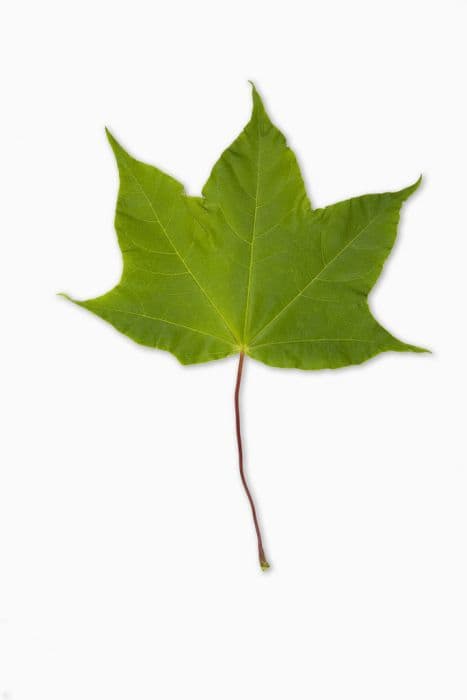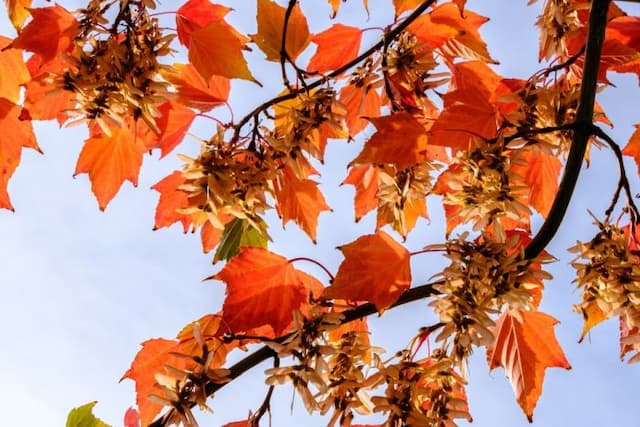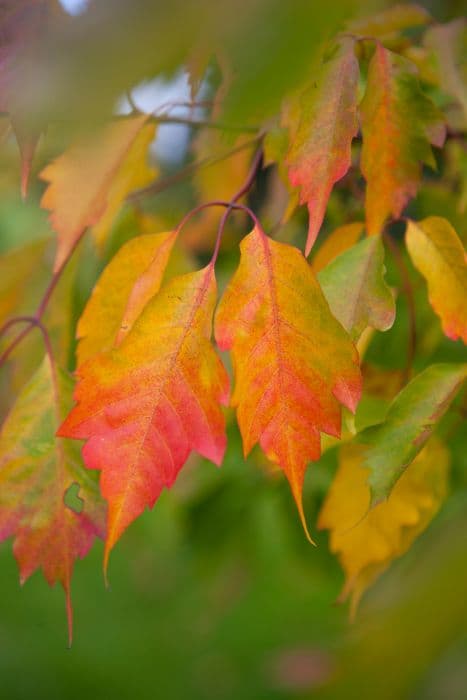Japanese Maple Acer palmatum Dissectum Viride Group

ABOUT
Acer palmatum Dissectum Viride Group, commonly known as the Japanese maple, is a stunning variety celebrated for its ornamental qualities. This particular group of Japanese maples is noted for its distinctive foliage and elegant growth habit. The leaves are a true spectacle, deeply serrated and finely cut, resembling delicate lace. The texture they lend to the garden is one of fine filigree, providing a softness that can contrast beautifully with more solid or broad-leaved plants. The Japanese maple leaves in the Dissectum Viride Group are imbued with a lush, vibrant green color that captures the light and creates a radiant display in any garden. During different seasons, the leaves may undergo a transformation, presenting a range of hues that could include golden tones or fiery shades. The overall appearance of the foliage offers a feathery, fern-like look, which sways gracefully in the breeze. The plant's growth habit is usually described as artful and weeping, with branches that cascade downwards in a manner that is both elegant and controlled. This gives the Japanese maple a sculptural quality, making it a focal point in landscaping. The intricate intertwining of its branches can create a natural, serene ambiance, and the plant typically carries itself with a poise that is characteristic of many well-appointed Japanese gardens. As seasons change, the Japanese maple becomes a canvas of color; its leaves might turn varying colors before they finally drop, leaving behind a delicate tracery of slender branches. These branches, which can be twisted or gnarled, add to the visual interest of the plant, especially in the winter months when the foliage is no longer present to soften its outline. Without going into its specific dimensions, Acer palmatum Dissectum Viride Group is generally moderate in size and can fit into a variety of garden spaces. Its roots are also non-invasive, making it a safe choice for planting near paths or structures. It's a popular choice for those looking to create an atmosphere of tranquility and natural beauty with a plant that has year-round visual appeal.
About this plant
 Names
NamesFamily
Sapindaceae.
Synonyms
Green Laceleaf Japanese Maple, Green Threadleaf Japanese Maple, Green Cutleaf Japanese Maple.
Common names
Acer palmatum Dissectum Viride Group.
 Toxicity
ToxicityTo humans
The plant known as Japanese maple is not toxic to humans. Ingesting parts of the Japanese maple generally does not cause poisoning or adverse health effects.
To pets
The Japanese maple is also non-toxic to pets. It is not known to cause any symptoms of poisoning in animals if they ingest parts of the plant. Therefore, it is generally considered safe in landscapes and gardens where pets may have access to it.
 Characteristics
CharacteristicsLife cycle
Perennials
Foliage type
Deciduous
Color of leaves
Green
Height
6-8 feet (1.8-2.4 meters)
Spread
6-10 feet (1.8-3.0 meters)
Plant type
Tree
Hardiness zones
5-8
Native area
Japan
Benefits
 General Benefits
General Benefits- Aesthetic Appeal: The 'Japanese Maple' adds ornamental value to landscapes with its finely cut, delicate leaves and cascading habit.
- Seasonal Color: Offers a range of colors throughout the seasons – with green leaves turning to vibrant shades of yellow, red and purple in autumn.
- Shade Tolerance: Adapted to grow in partially shaded environments, making it versatile in garden design.
- Compact Size: Generally remains small to medium in size, suitable for use in limited spaces and smaller gardens.
- Low Maintenance: Requires minimal pruning and can thrive without extensive care, ideal for both experienced and novice gardeners.
 Medical Properties
Medical PropertiesThis plant is not used for medical purposes.
 Air-purifying Qualities
Air-purifying QualitiesThis plant is not specifically known for air purifying qualities.
 Other Uses
Other Uses- The Japanese maple can be used in bonsai creation due to its small leaves, attractive color, and the ease with which it can be trained and pruned.
- Branches and leaves of the Japanese maple are sometimes used in floral arrangements, particularly in Japanese Ikebana, to add unique shapes and colors.
- In garden design, it is often used as a specimen tree to create a focal point in both large and small landscapes.
- The wood of the Japanese maple is occasionally used in woodworking for making small, decorative objects where its grain and color can be appreciated.
- During the fall, the leaves can be collected and pressed to create natural art projects or used in crafts for their vibrant colors.
- The tree's striking appearance is sometimes incorporated into photography projects or used as a backdrop for portrait sessions.
- Its delicate form and color are inspirational for artists and can be used as a subject in painting or drawing nature studies.
- In Japanese culture, the tree can represent peace and serenity and may be planted in gardens designed for contemplation and meditation.
- The interesting texture and form of the tree make it an ideal candidate for garden photography, teaching techniques such as depth of field and composition.
- Leaf shapes and patterns of the Japanese maple can be used in educational settings to teach about plant morphology and diversity.
Interesting Facts
 Feng Shui
Feng ShuiThe Japanese Maple is not used in Feng Shui practice.
 Zodiac Sign Compitability
Zodiac Sign CompitabilityThe Japanese Maple is not used in astrology practice.
 Plant Symbolism
Plant Symbolism- Peace: The delicate and intricate foliage of the Japanese Maple is often associated with tranquility and calmness, symbolizing peace and serenity in the garden.
- Balance: With its beautifully balanced branches and leaves, the Japanese Maple represents harmony and equilibrium in life.
- Elegance: The grace and ornate detail of its leaves convey a sense of elegance and sophistication, making the Japanese Maple a symbol of beauty and refinement.
- Endurance: Japanese Maples can live for many years, enduring through changing seasons, which makes them a symbol of strength and resilience.
- Change: The changing color of the leaves throughout the seasons reflects the transient nature of life, symbolizing change and the cycle of life.
 Water
WaterLaceleaf Japanese Maples, including the Acer palmatum Dissectum Viride Group, prefer consistently moist soil and should not be allowed to dry out completely. During the growing season, they may need watering once or twice a week, depending on weather conditions. It's essential to water deeply and thoroughly, providing about 10-15 gallons of water per week for established trees. Adjust the amount based on rainfall, more during dry spells and less when it's rainy. Ensure the water penetrates the soil to reach the root zone.
 Light
LightLaceleaf Japanese Maples require a spot that offers partial shade, especially to protect them from the harsh afternoon sun. They thrive under the dappled light of taller trees or in an area that receives morning sun and afternoon shade. Protecting them from strong winds will also help preserve their delicate foliage.
 Temperature
TemperatureLaceleaf Japanese Maples perform best in a temperature range where summers are not extremely hot and winter temperatures don't fall below -10 to -20 degrees Fahrenheit. They can withstand a brief period of cold down to -20 degrees Fahrenheit, but prolonged exposure can be harmful. Ideally, daytime temperatures should be moderately warm and nights cool.
 Pruning
PruningPruning Laceleaf Japanese Maples is mainly for shaping and removing dead or damaged branches, enhancing their graceful habit. Prune during the dormant season, preferably late winter before new growth starts. Thinning cuts should be made to keep the branching structure open, typically once a year or less frequently as the tree matures.
 Cleaning
CleaningAs needed
 Soil
SoilJapanese Maple thrives in well-draining, slightly acidic soil with a pH of about 5.5 to 6.5. The best soil mix can be created using one part each of peat moss, pine bark, and coarse sand or perlite, promoting aeration and proper moisture retention for the roots.
 Repotting
RepottingJapanese Maples in containers should be repotted every 2-4 years to prevent root binding and to replenish nutrients in the soil. It's best to repot in late winter or early spring before new growth begins.
 Humidity & Misting
Humidity & MistingJapanese Maples prefer moderate humidity levels but are adaptable to different humidity conditions typical of temperate climates. They generally do well outdoors where the natural environment helps regulate humidity around them.
 Suitable locations
Suitable locationsIndoor
Place Japanese Maple in bright, indirect light, and ensure good airflow.
Outdoor
Plant in dappled shade, shelter from strong winds, well-draining soil.
Hardiness zone
5-9 USDA
 Life cycle
Life cycleThe life of Acer palmatum Dissectum Viride Group, commonly known as the Laceleaf Japanese Maple, begins with germination from seed; under favorable conditions, these seeds sprout and establish a root system. Seedlings then enter a juvenile vegetative stage, where they rapidly develop stems and dissected, lace-like leaves characteristic of the cultivar, utilizing sunlight for photosynthesis and growth. After a few years, the sapling matures into an adult tree and starts the reproductive stage, producing flowers that are often inconspicuous, followed by the development of samaras, which are winged seeds that facilitate wind dispersal. Upon reaching maturity, the Laceleaf Japanese Maple enters a period of annual growth and reproduction, where it experiences seasonal cycles of leaf growth in the spring, seed maturation in the summer, and leaf senescence in the fall, with leaves changing to vibrant colors before dropping. This deciduous tree continues this cycle for many years, with some specimens living over a century if grown under optimal conditions and with proper care. Eventually, senescence of the entire tree occurs, leading to reduced vigor and, finally, the death of the organism.
 Propogation
PropogationPropogation time
Late winter-early spring
The Japanese Maple Acer palmatum 'Dissectum Viride Group' is commonly propagated through softwood cuttings. The most popular method involves taking cuttings in the late spring or early summer when the new growth is partially mature but still supple. Cut a piece of stem around 4 to 6 inches (10 to 15 centimeters) long, making sure it contains at least two or three sets of leaves. The lower leaves are then removed and the cut end is dipped in rooting hormone to encourage root development. The cutting is then inserted into a pot filled with a mix of peat and perlite or a well-draining potting soil. To maintain high humidity, a plastic bag or a propagator can be placed over the pot, and it should be kept in indirect sunlight until roots have established, after which it can be transplanted into the garden or a larger pot.









